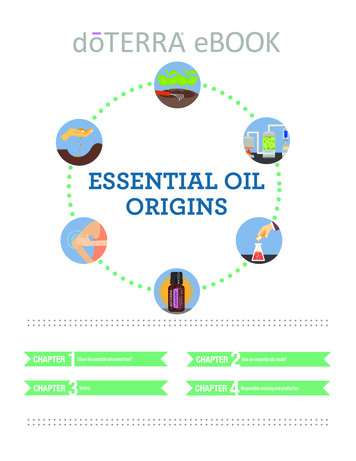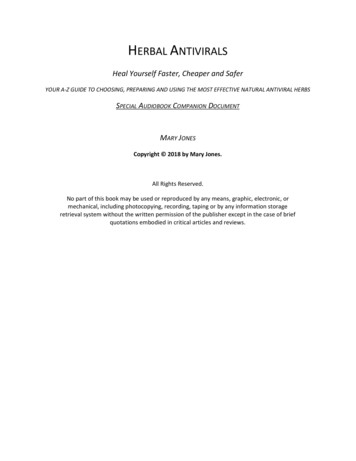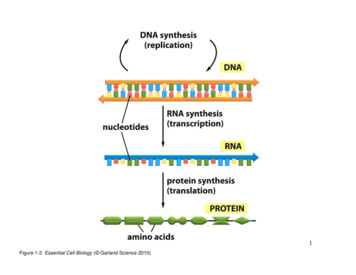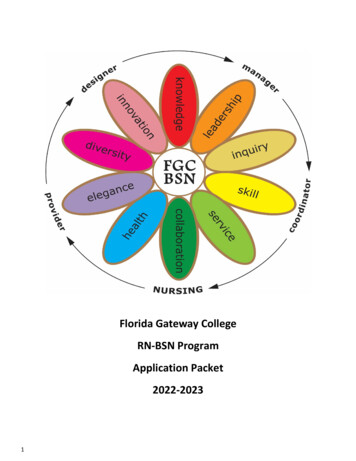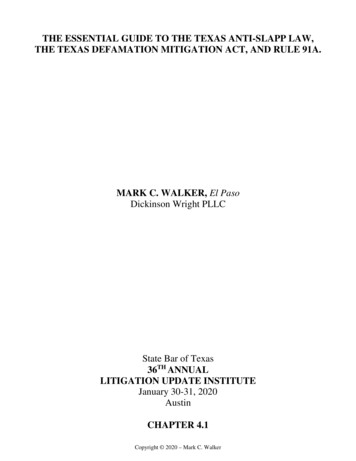
Transcription
THE ESSENTIAL GUIDE TO THE TEXAS ANTI-SLAPP LAW,THE TEXAS DEFAMATION MITIGATION ACT, AND RULE 91A.MARK C. WALKER, El PasoDickinson Wright PLLCState Bar of Texas36TH ANNUALLITIGATION UPDATE INSTITUTEJanuary 30-31, 2020AustinCHAPTER 4.1Copyright 2020 – Mark C. Walker
The Essential Guide to the Texas Anti-SLAPP Law, the Texas Defamation Mitigation Act, and Rule 91aChapter 4.1TABLE OF CONTENTSI.INTRODUCTION. . 1II.THE TEXAS CITIZENS PARTICIPATION ACT: WHAT IS IT? . 3A. Background and Enactment of the TCPA. . 31. What is a SLAPP lawsuit? . 32. Alleged Purpose: Prevent Frivolous Suits. . 43. All Statutory Construction Must Be in Service of the Legislature’s StatedDual Purposes. . 44. Legislative History 2011 - A Solution in Search of a Problem: UnderlyingPurpose is the Protection of Media Defendants. . 55. The 2013 Amendments: Still Media-Driven. . 76. 2019 Legislative history: finally, some action, despite media resistance. . 8III. APPLICATION OF THE TCPA. 9A. What is a “legal action” under the TCPA? . 9B. Are TCPA motions to dismiss “legal actions” subject in turn to a responsive,or counter, motion to dismiss under the TCPA? . 10C. Is a Rule 202 petition considered a “legal action” subject to a motion to dismiss? . 12D. Do certain statutory, or other actions, such as for declaratory judgment, not qualifyas “legal actions” under the TCPA? Does the construction clause provide a way outfor statutory claims or remedies? . 12E. What nexus is required between the “legal action” and the rights protected under theTCPA, and why did the Legislature delete “relates to”? . 14F. What speech rights are protected, is a hypythetical communication covered, and whatdoes in connection with mean? . 16G. Public or Private? Does it matter where communications occur? . 18H. What is a “matter of public concern,” and how does a court make the determination? . 18I. What are the rights of petition that are protected?. 20J. What are the rights of association that are protected, and are organizations now protectedunder the TCPA? . 22K. Exemptions from the TCPA. . 23L. Procedures and Proof. 261. Lawyers MUST KNOW this Threshold Dispositive Motion. . 262. Deadline to File the Motion, and Whether Amendment of Pleadings Extends the Deadline. . 273. Deadline for Hearing and Ruling: “Set,” “Rule,” and Continuances. . 284. Discovery Stay – But Limited Discovery for “Good Cause.” . 29M. Standards and Burdens of Proof/Actions by Court. . 301. What role does the trial court play? . 302. Proof: what type of evidence may be considered, and can live testimony be presented? . 303. Burden of Proof on the Movant – “Demonstrate.” . 314. Burden of Proof on the Respondent. 325. Affirmative Defenses May Be the Basis of Motions to Dismiss. . 366. Ruling by the Court – Dismissal Mandatory. . 367. Request for Ch. 27 Sanctions Likely Survive Nonsuit or Amended Petition DroppingSome Claims. . 36N. Mandatory, Not Discretionary, Award of Reasonable Fees for Movant Upon Dismissalof Legal Action. . 37O. The lodestar base. . 381. Rates must be reasonable. . 382. The amount of time must be reasonable. . 39P. Sanctions are now discretionary and must be accompanied by findings. 39Q. TCPA: Award of Fees, Not Sanctions, for Respondent/Plaintiff – Predicated on FrivolousMotion to Dismiss, Unless Based on Responsive Motion to Dismiss the Initial Motion to Dismiss. 40R. Miscellaneous 2019 Amendments. . 40S. Appellate Review. . 40i
The Essential Guide to the Texas Anti-SLAPP Law, the Texas Defamation Mitigation Act, and Rule 91aChapter 4.11. Interlocutory Appeal: Stay of Proceedings, and What is Reviewable? . 402. Motion to Dismiss Timely Granted . 413. Deadlines for Chapter 27 Appeal or Writ. . 424. Any Appeal or Writ From An Order On A Chapter 27 Motion to Dismiss Shall be Expedited. . 425. Standard of Review of Interlocutory Appeal. . 43T. Does the TCPA Apply in Federal Court? . 44U. Constitutional Issues. 451. Does the TCPA violate the Open Courts provision of the Texas Constitution?. 452. Does the TCPA Violate the Right to Due Process? . 463. Does the Act Violate the Right to a Trial by Jury?. 474. Does the Act Conflict with the Supreme Court’s Rule-Making Authority?. 485. Does the Statute Conflict With Texas’ Constitutional Protection of Rights to Suefor Reputational Torts? . 49IV. UNINTENDED CONSEQUENCES. . 50A. Overbroad Application and Chilling Effect on Meritorious Business Tort Actions. . 50B. Justice Delayed is Justice Denied. . 51C. When The Texas Attorney General Must Be Invited to the Party. 51V. THE TCPA – CONCLUSIONS DRAWN. . 52VI. THE “MULLIGAN BILL”: THE TEXAS DEFAMATION MITIGATION ACT. . 52A. Legislative History. . 52B. Application of the Defamation Mitigation Act: Prerequisites to Filing Defamation Suit,Request and Response, Abatement. 54C. Limitations of Damages. . 55D. Harmonizing (or Conflicting) With Texas Citizens Participation Act. . 55ADDENDUM A - H.B. 2730. 57ii
The Essential Guide to the Texas Anti-SLAPP Law, the Texas Defamation Mitigation Act, and Rule 91aSLAPP laws only to communications in the course of“public participation” in a governmental process, suchas in a public hearing, supporting or opposing permitapplications, litigation, and the legislative process. TheTexas statute has no such limitation, and applies beyondparticipation in governmental processes.Over the last eight years the TCPA launched a newand very expensive motions practice, clogging thedockets of trial and appellate courts with expensive,complicated, and time-consuming litigation, that oftenresult in fee awards in the hundreds of thousands ofdollars. 7 Seemingly catching Texas practitioners offguard, the law instead proved to be an “across-the-boardgame-changer in Texas civil litigation.” 8In 2017 there were 4 opinions from the TexasSupreme Court, and 22 from the courts of appeals. Inthe first six months of 2018, there were 8 opinions fromthe Texas Supreme Court, and 36 from the courts ofappeals. Through the end of December, 2019, therewere 340 Texas appellate opinions on the TCPA, ofwhich 13 came from the Texas Supreme Court.Opinions from the Amarillo (13), Austin (49),Beaumont (8), Corpus Christi (15), Dallas (81),Eastland (6), El Paso (7), Fort Worth (26), Houston [1st](52), Houston [14th] (30, San Antonio (20), Texarkana(4), Tyler (8), and Waco (8) make up the balance of thereported appellate decisions.The TCPA gained momentum almost every year,with 121 decisions in 2019, 94 in 2018, 47 in 2017, 55in 2016, 40 in 2015, 25 in 2014, 21 in 2013, 4 in 2012,and none in 2011.At one point in 2018, roughly 40 percent of theentire docket in the Dallas Court of Appeals consistedof TCPA cases. In March, 2019, there were 15 TCPAcases pending at the Texas Supreme Court.Going beyond appellate cases, nearly 100,000documents in Texas court referenced the TCPA in 2018alone. 9THE ESSENTIAL GUIDE TO THETEXAS ANTI-SLAPP LAW, THETEXAS DEFAMATION MITIGATIONACT, AND RULE 91AI.Chapter 4.1INTRODUCTION.The “general right of an individual to be letalone is like the right not to be assaulted orbeaten, the right not to be imprisoned, theright not to be maliciously prosecuted, theright not to be defamed.” 1“Unlike the United States Constitution, theTexas Constitution twice expressly guaranteesthe right to bring reputational torts.” 2The landscape of Texas civil litigation significantlychanged when on June 17, 2011, Texas Governor RickPerry approved the new Texas anti-SLAPP 3 law,entitled the Texas Citizens Participation Act (the“TCPA”), and in so doing Texas joined 27 states and theDistrict of Columbia in enacting various forms oflegislation purportedly aimed at preventing frivolouslawsuits from stifling free speech activities and therights of petition and association. 4 As interpreted andapplied, the TCPA is arguably the broadest anti-SLAPPlaw in the nation, which was the conclusion shared withthe authors of the 2019 amendments to the TCPA. TheTexas statute was one of 11 anti-SLAPP statutes enactedin 2010-2011. 5 Only Oklahoma (2014) and Kansas(2016) have enacted anti-SLAPP legislation since2011. 6 Seventeen states have no anti-SLAPP law at all.Fourteen states expressly apply their anti-SLAPPstatutes to communication involving rights protected bythe U.S. and their state’s constitutions, though the Texaslaw is not so limited. Twelve states limit their anti1athttp://www.texaslawyer.com/id as-Animal-Anti-SLAPPKingdom; 350,000 in fees and 250,000 in sanctions againstSchlumberger, August 2014. See Jeremy Heallen,Schlumberger Fined, Trade Secrets Suit Against Ex-AttyGutted, Law360 (Aug. 27, 2014), available ; 124,000 infees awarded, to be increased. See John C. Council, Video:Winning Attorney Fees Under Texas’ Anti-Slapp Statute (andthen some?), Texas Lawyer (Feb. 4, 2015), available athttp://www.texaslawyer.com/id as-AntiSLAPP-Statuteand-then-some.8Serafine v. Blunt, 466 S.W.3d 352, 365 (Tex. App.—Austin2015, no pet.) (Pemberton, J., concurring).9See Briefing Document: H.B. 2730 (Engrossed), Tex. H.B.2730, 86th Leg., R.S. (2019) (stating “99,300 documents wereLouis D. Brandeis and Samuel D. Warren, The Right toPrivacy, 4 HARV. LAW REV. 193, 205 (1890).2Neely v. Wilson, 418 S.W.3d 52, 60 (Tex. 2013).3“Strategic Lawsuits Against Public Participation.”4See TEX. CIV. PRAC. & REM. CODE § 27.001 et seq. The 27other states, in addition to the District of Columbia, areArizona, Arkansas, California, Delaware, Florida, Georgia,Hawaii, Illinois, Indiana, Louisiana, Maine, Maryland,Massachusetts, Minnesota, Missouri, Nebraska, Nevada, NewMexico, New York, Oklahoma, Oregon, Pennsylvania,Rhode Island, Tennessee, Utah, Vermont, and Washington.Colorado recognizes similar protection through common law.5See Reports of the Public Participation Project, www.antislapp.org.6Id.7 624,000 in fees and costs awarded in February, 2017, and 60,000 in fees and sanctions in July, 2017. See John C.Council, Litigator of the Week: The King of Texas’ AnimalAnti-Slapp Kingdom, Texas Lawyer (Aug. 3, 2017), available1
The Essential Guide to the Texas Anti-SLAPP Law, the Texas Defamation Mitigation Act, and Rule 91aChapter 4.1The TCPA introduces what one judge hearingprobably the first TCPA motion to dismiss called a“draconian” motion to dismiss that places a heavyburden on the aggrieved plaintiff to prove that his suit isnot frivolous at the inception of the litigation without thebenefit of any meaningful discovery. 10 Pleadingbecame more of an art form for plaintiff lawyers,because “any skilled litigator could figure out a way tofile a motion to dismiss under the TCPA in nearly everycase.” 11The Act did not attempt to define the shape orscope of a true SLAPP suit or distinguish betweencauses of action subject to or protected from the antiSLAPP statute. Instead, the TCPA has been applied toa very broad array of claims that do not resemble aSLAPP case, including UCC-1 financing statements, 12theft of trade secrets, 13 breaches of nondisclosureagreements, 14 and a host of other business, commercialand personal disputes. In fact, very few of the casescurrently making their way through the appellate courtscould properly be characterized as a SLAPP case. Solong as a defendant in a suit that involves acommunication can characterize the suit as eventangentially “based on,” “relating to,” or “in responseto” the exercise of free speech, petition or association,the motion to dismiss can be filed, and unless theplaintiff presents prima facie evidence of each elementof his claim, the motion to dismiss must be granted, withmandatory fees and sanctions assessed. 15Our research also shows that, when confrontedwith a TCPA motion to dismiss, plaintiffs are almostcertain to lose all or part of their cases to dismissal.Although there are no reported statistics on the numberof TCPA motions to dismiss granted at the trial level,we do have a record of results on appeal. Since only themovant whose motion to dismiss is denied is entitled toan interlocutory appeal, 16 a review of results on appealshows that more than 70% of appealed cases concludewith the motion to dismiss being granted in whole or inpart. 17 Coupled with some sense of cases in which thefiled referencing the TCPA [in 2018]”) (provided by LaurenYoung, Chief of Staff for Rep. Jeff Leach) [hereinafter H.B.2730 Briefing Doc.] at p. 2.10In a campaign finance law case, the Mayor of El Paso filedsuit to enjoin violations of the Texas Elections Code byseveral corporations and a group of individuals. Thedefendants filed a motion to dismiss under the lawsuit underthe new anti-SLAPP statute, arguing that the corporatecontributions at issue in the case were a form of “protectedspeech.” In denying the motion to dismiss, Judge JavierAlvarez stated that the new procedure for dismissal of alawsuit without discovery and with the burden on the plaintiffwas too draconian. The author of this paper was counsel forthe plaintiff in that case, and received a rude introduction tothe TCPA in one of its first applications. See Cook v. TomBrown Ministries, et al., 385 S.W.3d 592 (Tex.App.—El Paso2012, pet. denied) (related interlocutory appeal of temporaryinjunction).11Neyland v. Thompson, No. 03-13-00643-CV, 2015 WL1612155, at *12, 2015 Tex. App. LEXIS 3337 at *42 (Tex.App.—Austin Apr. 7, 2015, no pet.) (mem. op.) (Field, J.,concurring).12See Quintanilla v. West, No. 04-16-00533-CV, 2017 WL1684832 (Tex. App.—San Antonio April 26, 2017, pet. filed).13See Elite Auto Body LLC v. Autocraft Bodywerks, Inc., 520S.W.3d 191, 203-04 (Tex. App. – Austin 2017, pet. dism’d).14See Elliott v. S&S Emergency Training Solutions, No. 0516-01373-CV, 2017 WL 2118787 (Tex. App.—Dallas May16, 2017, pet. granted).15TEX. CIV. PRAC. & REM. CODE § 27.003 & 27.005.16TEX. CIV. PRAC. & REM. CODE § 27.008.17Mario Franke, in our office, reviewed the cases appealedsince the inception of the statute, and counted a case once ininstances of more than one opinion.SUMMARY OF FINDINGS:2017For 2017, there are a total of 37 reported cases on WestLaw.Of these, 27 of the reported cases granted the TCPA motionto dismiss at issue (either whole or in part). This constitutesa 72.97% percentage success rate for TCPA motions inreported cases for 2017.Notably, to date, there have been already four (4) SupremeCourt cases (Hersh v. Tatum; Bedford v. Spassof; D MagazinePartners, L.P. v. Rosenthal; and ExxonMobil Pipeline Co. v.Coleman) addressing TCPA motions.2016For 2016, there are a total of 40 reported cases on WestLawaddressing TCPA motions to dismiss (excluding opinions thatwere subsequently addressed by Supreme Court, orsubstituted on rehearing, or on remand).Of these, 22 of the reported cases granted the TCPA motionto dismiss (either whole or in part). This constitutes a 55.00%percentage success rate for TCPA motions in reported casesfor 2016.2015For 2015, there are a total of 37 reported cases on WestLawaddressing TCPA motions to dismiss (excluding opinions thatwere subsequently addressed by Supreme Court, orsubstituted on rehearing, or on remand).Of these, 26 of the reported cases granted the TCPA motionto dismiss (either whole or in part). This constitutes a 70.27%percentage success rate for TCPA motions in reported casesfor 2015.2014For 2014, there are a total of 21 reported cases on WestLawaddressing TCPA motions to dismiss (excluding opinions thatwere subsequently addressed by Supreme Court, orsubstituted on rehearing, or on remand).Of these, 14 of the reported cases granted the TCPA motionto dismiss (either whole or in part). This constitutes a 66.66%percentage success rate for TCPA motions in reported casesfor 2014.2013For 2013, there are a total of 13 reported cases on WestLawaddressing TCPA motions to dismiss (excluding opinions that2
The Essential Guide to the Texas Anti-SLAPP Law, the Texas Defamation Mitigation Act, and Rule 91amotion to dismiss is granted at the trial court, it is simplemath to infer that the success rate of TCPA motions todismiss must be greater than 90%.The passage of the TCPA unleashed on Texascourts a torrent of motions to dismiss, and as a result theLegislature took steps in 2019 to attempt to narrow thescope of the TCPA.This paper is offered as a guide through the historyof the TCPA, an outline of its provisions andapplication, and a navigation map for tactical andstrategic considerations in its application and use, withmany problems identified and discussed. With the sheernumber of cases decided in recent years, it is impossibleto review every TCPA case published.Chapter 4.1the project into defending the lawsuit, and bytransforming the debate from a political one to a judicialone, with a corresponding shift of issues from thetargets’ grievances to the filers’ grievances.” 21 The goalof a SLAPP suit is to “stop citizens from exercising theirpolitical rights or to punish them for having done so.” 22None of the reported Texas decisions to date defines thescope of a SLAPP suit, and the Texas Legislaturecuriously never referred to SLAPPs in the legislation.By definition, in the “typical” SLAPP case themotivation of the plaintiff is not to achieve a legalvictory resulting in a judgment, but instead to make itprohibitively expensive and burdensome for thedefendant to continue participation in herconstitutionally protected activity. In other words,improper motive is an essential element of a SLAPPlawsuit. The concept assumes that the SLAPP plaintiffenjoys a great advantage in resources to fund litigation,and can afford to overwhelm the opposition withsignificant lawsuit expenses and fees.As onecommentator explained, “[t]he typical SLAPP suit isbrought by a well-heeled ‘Goliath’ against a ‘David’with fewer resources, trying to keep David fromopposing, for example, Goliath’s development plans orother goal.” 23 The developer tale is a frequently citedexample of a SLAPP suit. 24A true SLAPP case is a type of lawsuit abuse that,if allowed to flourish, would threaten the discourse andcriticism of public issues that are essential in selfgovernment. If indeed the purpose and application ofthis law are congruent, Chapter 27 would provide aII. THE TEXAS CITIZENS PARTICIPATIONACT: WHAT IS IT?A. Background and Enactment of the TCPA.1. What is a SLAPP lawsuit?The consensus view among commentators is thatSLAPP suits are “legally meritless suits designed, fromtheir inception, to intimidate and harass political criticsinto silence.” 18 Hawaii defines a SLAPP suit as “alawsuit that lacks substantial justification or isinterposed for delay or harassment and that is solelybased on the party’s public participation before agovernmental body.” 19 According to some views, thetypical SLAPP plaintiff “does not seek victory on themerits, but rather victory by attrition.” 20 The “object isto quell opposition by fear of large recoveries and legalcosts, by diverting energy and resources from opposing22were subsequently addressed by Supreme Court, orsubstituted on rehearing, or on remand).Of these, 10 of the reported cases granted the TCPA motionto dismiss (either whole or in part). This constitutes a 76.92%percentage success rate for TCPA motions in reported casesfor 2013.Notably, the vast majority of denials for TCPA motions areprocedural nature (i.e., tardy appeals; movants not fulfillingthe first prong the TCPA and therefore the Court of Appealsfailing to have jurisdiction to address the merits of the claims).However, once the reviewing courts do address the claims setforth by the non-movant in a particular case, the result islargely an Order granting of the movant’s TCPA motion inwhole or in part.18Mark J. Sobczak, Symposium: The Modern AmericanJury: Comment: Slapped in Illinois: The Scope andApplicability of the Illinois Citizen Participation Act, 28 N.Ill. U. L. Rev. 559, 560-61 (2008), quoting EdmondCostantini & Mary Paul Nash, SLAPP/SLAPP back: TheMisuse of Libel Law for Political Purposes and CountersuitResponse, 7 J.L. & POL 417, 423 (1991).19HAW. REV. STAT. § 634F-1 (2011).20Sobczak, supra, at 561.21Id., quoting Jerome I. Braun, Increasing SLAPP Protection:Unburdening the Right of Petition in California, 32 U.C.DAVIS L. REV. 965, 969-70 (1999).Id., citing George W. Pring, SLAPP: Strategic LawsuitsAgainst Public Participation, 7 PACE ENV’L. L. REV. 3, 5-6(1998).23Richard J. Yurko and Shannon C. Choy, Legal Analysis:Reconciling the anti-SLAPP Statute With Abuse of Processand Other Litigation-Based Torts, 51 B.B.J. 15, 15 (2007).24See John G. Osborn and Jeffrey A. Thaler, Feature:Maine’s Anti-SLAPP Law: Special Protection AgainstImproper Lawsuits Targeting Free Speech and Petitioning,23 MAINE BAR J. 32 (2008). A powerful developer files afrivolous defamation lawsuit against a group of outspokenhomeowners that oppose the developer’s plans to build anindustrial facility in their backyard. The developer’scomplaint “is sufficiently drafted to survive [a] motion todismiss, and the developer then embarks upon a course ofoppressive discovery and motion practice, forcing thedefendants to engage in extensive document production and aseemingly endless string of depositions.” “After years oflitigation, the defendants prevail at summary judgment ortrial--but the victory is, in fact, the developer’s. The cost,stress and time involved in defending against the suit hasfractured the community group, sapped the energy andfinancial resources of the group’s members, diverted theirefforts from actually opposing the industrial plant and chilledthe likelihood of future opposition to similar projects becauseof the toll the lawsuit took on the group and its members.” Id.3
The Essential Guide to the Texas Anti-SLAPP Law, the Texas Defamation Mitigation Act, and Rule 91asalutary benefit consistent with the traditional fiercedefense Americans have provided to free speech rights.Whether the law applies in limited circumstances toprevent actual intimidation of free speakers, or iscoercively used to chill litigation that was brought toprotect business and personal reputations, remains to beseen as an increasing number of these TCPA casesproceed through litigation.Chapter 4.1lacking, or why Chapters 9 and 10 of the Texas CivilPractice and Remedies Code should not be amended toaddress an unmet need. 27 Cases involving speech andtraditional First Amendment rights are not exemptedfrom the frivolous case deterrence functions of Rule 13and Chapters 9 and 10. In fact, Chapter 9 specificallyapplies to cases involving defamation and tortiousinterference. 28When the Legislature took up the TCPA in 2019, itagain failed to identify any unmet needs, or to addresswhether there was any “wave” of SLAPP cases thatwould justify the creation of a “tsunami” of TCPAmotions to dismiss.2.Alleged Purpose: Prevent Frivolous Suits.The Citizens Participation Act was theoreticallyenacted to provide an expedited procedure to dismissretaliatory, frivolous lawsuits that chill free speech. TheAct’s legislative history states that it was intended totarget “frivolous lawsuits aimed at silencing citizenswho are participating in the free exchange of ideas” and“frivolous lawsuits aimed at retaliating against someonewho exercises the person’s right of association, freespeech, or right of petition.” 25Yet the Legislature in 2011 did not discuss theapplicability of existing anti-frivolous lawsuit rules andstatutes, 26 or how such established body of law wasinadequate to curtail any perceived harm. Although theLegislature has been nothing less than vigilant regardingany litigation perceived as frivolous, and the politicalcommittee Texans For Lawsuit Reform (“TLR”) did notrecognize SLAPPs as an issue of concern, SLAPP caseswere not involved in any of the comprehensive tortreform efforts over the last 20 years, and TLR wasuninvolved in the adoption or amendment of the TCPA.Nothing in the 2011 legislative history of the Actdiscusses why the existing statutory framework fordiscouraging frivolous suits of all kinds was found3.All Statutory Construction Must Be in Service ofthe Legislature’s Stated Dual Purposes.In adding a new chapter to the Texas Civil Practiceand Remedies Code, 29 the Legislat
The landscape of Texas civil litigation significantly changed when on June 17, 2011, Texas Governor Rick Perry approved the new Texas anti-SLAPP. 3. law, entitled the Texas Citizens Participation Act (the "TCPA"), and in so doing Texas joined 27 states and the District of Columbia in enacting various forms of




